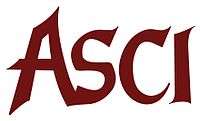American Society for Clinical Investigation
The American Society for Clinical Investigation (ASCI), established in 1908, is one of the oldest and most respected medical honor societies in the United States.

Organization and purpose
The ASCI is an honorary society to which more than 2,800 physician-scientists from all medical specialties belong. Prospective members are proposed by standing members of the society and elected to ASCI on the basis of an outstanding record of scholarly achievement in biomedical research. The ASCI includes physician-scientists who are active clinically, in basic research, or in teaching. Many of its senior members are widely recognized leaders in academic medicine. As of 2015 the membership of ASCI has included 417 members of the National Academy of Medicine, 191 members of the National Academy of Sciences, Engineering, and Medicine, 40 Lasker Award winners, and 19 Nobel laureates.
The ASCI supports the research into basic mechanisms and/or treatment of human diseases, and to the education of future generations of physician-scientists. The ASCI considers the nominations of several hundred physician-scientists from the United States and abroad each year and elects up to 80 new members each year for their significant research accomplishments relatively early in their careers.
The ASCI is a member of the Federation of American Societies for Experimental Biology (FASEB), which includes numerous biomedical research societies. The ASCI publishes the peer-reviewed biomedical research journals Journal of Clinical Investigation and JCI Insight.
A collection of the society's papers is held at the National Library of Medicine.[1]
History
The American Society for Clinical Investigation has its origins in a chance meeting in June 1907 on the Atlantic City boardwalk, in which Samuel James Meltzer, David Linn Edsall, Wilder Tileston, Warfield Theobald Longcope, and probably Joseph Hersey Pratt were present ("ASCI Secretary’s Book, 1907–1965". History of Medicine Division. Bethesda, MD: National Library of Medicine.). The parties to this meeting considered the need for a new society, separate from the Association of American Physicians (AAP), whose membership was at that time limited to 160 individuals. The purpose of the new society would be to give younger men who were not yet members of the AAP, and not eligible for membership in the AAP, the advantages of meeting other young men active in medical research.[2] The new organization was formally constituted on May 11, 1908, at the New Willard Hotel in Washington. A total of 32 physicians agreed to become charter members of ASCI in 1908. The first meeting of the ASCI was held in Atlantic City on May 10, 1909.[3] The organization was also known as the "Young Turks" in allusion to the rebellious spirit in which it was founded, as a counterweight to the older and more deeply established Association of American Physicians (colloquially known as the "Old Turks" in subsequent years).[4]
References
- "American Society for Clinical Investigation Records 1907-1977". National Library of Medicine.
- Brainard, Ellen R. (1959). "History of the American Society for Clinical Investigation, 1909-1959". The Journal of Clinical Investigation. 38 (10): 1784–1837. doi:10.1172/JCI103958. PMC 444147. PMID 13803788. Retrieved 21 May 2018.
- Meltzer, S.J. (1909). "The science of clinical medicine: what it ought to be and the men to uphold it". Journal of the American Medical Association. 53: 508–512. doi:10.1001/jama.1909.92550070001001b. Retrieved 21 May 2018.
- "The Young Turks". Time. May 19, 1952. Retrieved 21 May 2018.
External links
- History of the ASCI, 1909-1959
- Website of the ASCI
- Honors accorded members of ASCI
- ASCI membership list
- American Society for Clinical Investigation Records (1907-1977)—National Library of Medicine finding aid